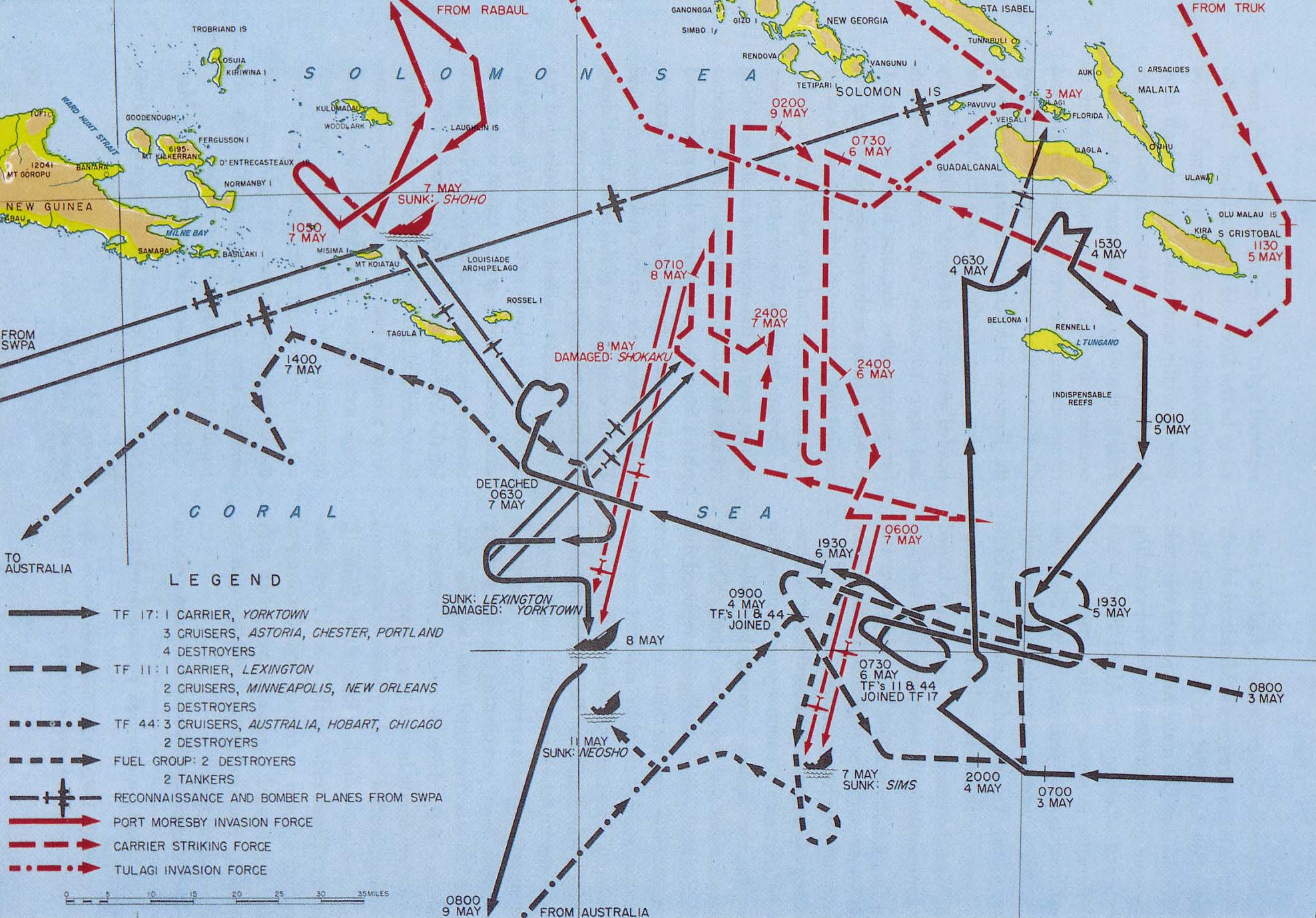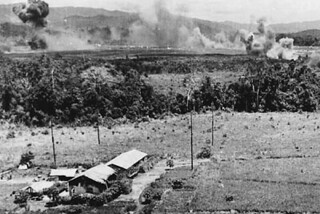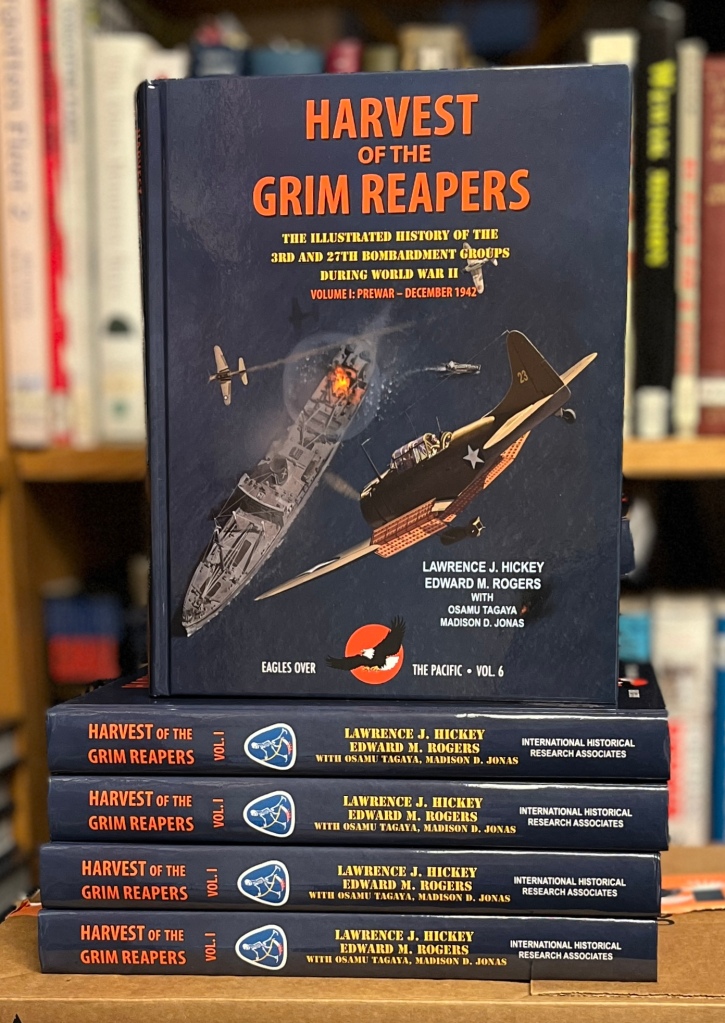The following excerpt comes from Warpath Across the Pacific. At this point in the story, the 345th Bomb Group is attacking Vunapope, located near Rabaul, on October 18, 1943.
“While the other squadrons were attacking the airfield, the six planes of the 500th swept wide and raced across the tree tops of a vast coconut plantation towards the supply dumps and docks along the bay just west of the airfield. Ahead, the pilots saw three freighters anchored close along the shore, and the flights lined up on the two largest, strafing their way across the shoreside supply dumps as they advanced. The flight led by 1/Lt. Max H. Mortensen aimed for a 5000-ton freighter on the right, while Capt. Anacker led his two wingmen towards the 6187-ton cargo-passenger ship Johore Maru on the left.
Mortensen released a single 1000-pound bomb which hit the water twenty yards short of the freighter, while Lt. Raymond Geer’s two bombs went long. The huge geysers thrown up seconds later by the exploding bombs completely obscured the ship. The airmen reported that they thought the bombs had rolled it over, but Japanese records do not support the claim that the ship was destroyed.
Mortensen’s flught pressed on over the bay and lined up on Subchaser #23 out in the channel. 1/Lt. Thane C. Hecox dropped his two 1000 pounders a few yards directly in front of the ship. The four-second delay fuses provided just enough time for the warship to run directly over the bombs before they exploded, ripping off the bow.
Meanwhile, Anacker’s flight was already in trouble. 1/Lt. Ralph G. Wallace’s TONDELAYO had lost its right engine to ground fire as it lined up on the target. From the top turret, S/Sgt. John Murphy could see a piston moving up and down through a jagged hole in a cylinder and the cowling. Wallace quickly feathered the prop and continued his bomb run. As the three planes approached the ship, the air was filled with machine-gun bullets and cannon shells as both the attackers and the defenders lashed out viciously. All three planes launched bombs as they neared the ship, one of which bounced off the deck and hit the water. Seconds later the target was surrounded by huge waterspouts as the bombs exploded, drenching the ship in spray. Crew interrogations indicated the bombs lifted the ship out of the water and debris was seen flying through the air; the ship was claimed as badly damaged and probably sunk. Again the claim was optimistic; Japanese records show that the Johore Maru was sunk by a submarine five days later.
Thirty minutes before the strafers hit Rapopo, a Jap spotter station on the east coast of New Britain had radioed a warning to the defenses. Pilots rushed to aircraft on alert status at the ends of the runways and took off in droves from the various airfields around Rabaul.
By the time the attack began, over a hundred Japanese Zeros from the 201st, 204th and 253rd Kokutais were echeloned above 5000 feet over St. George’s Channel and Blanche Bay. Before the Japanese pilots took on the strafers, they expected to have to deal with a larger fighter escort and formations of high-flying B-24s.
While the six squadrons of B-25s savaged the two airfields, the fighters continued to circle, unwilling to lose the advantage of their altitude. But when no fighter escort materialized and the 498th and 500th Squadrons reached the Channel, the Japanese Navy pilots reluctantly dropped the black noses of their Mitsubishi fighters and dove steeply to intercept the retreating formations. Thus, both lead squadrons of B-25s were met by a cascade of Japanese “Zekes” falling on them from above.
The air battle was joined almost as soon as the 498th Squadron crossed beyond the end of the runway at Ropopo and flew out over the water off Lesson Point. As each squadron of B-25s came off the target, it immediately dropped down as low as possible over the water and its flights reformed into a tight vee formation, thus bringing the maximum defensive fire power to bear. For the next twenty-five minutes the “Zekes” repeatedly attempted to break through he hail of .50-caliber tracers which greeted them at each advance towards the formations. Again and again, the massed fires of the turret and waist gunners shot them down or drove them off before their cannons and machine guns could do serious damage to the B-25s.
The 498th gunners were credited with ten kills and one probable, the 501st with ten more and three probables, and the 499th with two kills and one more probable. The 499th encountered less opposition because most of the Jap fighters followed the lead squadrons as they left the target.”












